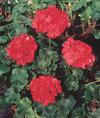- geranium
-
/ji ray"nee euhm/, n.1. any of numerous plants of the genus Geranium, which comprises the crane's-bills.2. the wild geranium, G. maculatum, of eastern North America, having loose clusters of lavender flowers.3. Also called stork's-bill. any of various plants of the allied genus Pelargonium, native to southern Africa, having showy flowers or fragrant leaves, widely cultivated in gardens and as houseplants.4. a flower of this plant.5. a vivid red color.[1540-50; < NL, for L geranion < Gk geránion name for various plants the fruit of which was thought to resemble a crane's bill, deriv. of géranos CRANE; akin to L grus]
* * *
Any of the approximately 300 species of perennial herbaceous plants or shrubs that make up the genus Geranium (family Geraniaceae), native mostly to subtropical southern Africa.They are among the most popular bedding and greenhouse plants. The closely related genus Pelargonium contains some 280 species of annual, biennial, and perennial herbaceous plants also commonly called geraniums. The showy, or Martha Washington, geraniums (P. x domesticum) have large pansylike flowers, few to the cluster. Some geraniums are grown as basket plants indoors and out; they are also used as ground covers in warm areas. Some species have fragrant leaves. Geranium oil smells like roses and is used chiefly in perfumes, soaps, and ointments. Hybrid geranium (Pelargonium × hortorum).John H. Gerard
Hybrid geranium (Pelargonium × hortorum).John H. Gerard* * *
▪ genus Geraniumalso called Cranesbill (genus Geranium)any of a group of about 300 species of perennial herbs or shrubs in the family Geraniaceae, native mostly to subtropical southern Africa. Geraniums are among the most popular of bedding and greenhouse plants. The closely related genus Pelargonium contains some 280 species of annual, biennial, and perennial herbaceous plants that are commonly called geraniums.The cultivated geraniums of the genus Pelargonium are herbaceous to woody, with thick fleshy leaves varying in shape from round to lobed to deeply cut; the flowers, borne in terminal clusters, vary in colour from white through shades of pink to deep red and violet. Most of the cultivated species are hybrids. Double flowers and mixed colours as well as ragged or frilled petals are available. While mostly propagated by stem cuttings, from which flowering plants can be produced in four or five months, geraniums are also grown from seed. Breeding and selection has resulted in a line of seed geraniums useful in bedding for their regular symmetry, elongated flower stalks, and habit of rapid and clean dropping of flower petals.The show, or Martha Washington, geraniums (P. × domesticum, largely derived from P. cucullatum, P. angulosum, and P. grandiflorum) have large pansylike flowers, few to the cluster. Zonal, house, or bedding geraniums (P. × hortorum, a complex hybrid largely derived from P. inguinans and P. zonale) are the familiar forms in garden culture and in pots indoors. Ivy, or hanging, geraniums (P. peltatum) are grown as basket plants indoors and out; they are also used as ground covers in warm areas. The aromatic, or scented-leaved, geraniums are found in several species, including P. abrotanifolium, P. capitatum, P. citrosum, P. crispum, P. graveolens, and P. odoratissimum. Minty, fruity, floral, and spicy fragrances are released readily when their leaves are rubbed or bruised.Several African Pelargonium species are commercially important for geranium oil, an essential oil used in perfumery. Geranium oil, which is also called pelargonium oil, or rose-geranium oil, is colourless to pale yellow-brown or greenish and has an odour like that of roses. It is used chiefly in perfumes, soaps, ointments, and tooth and dusting powders.* * *
Universalium. 2010.
